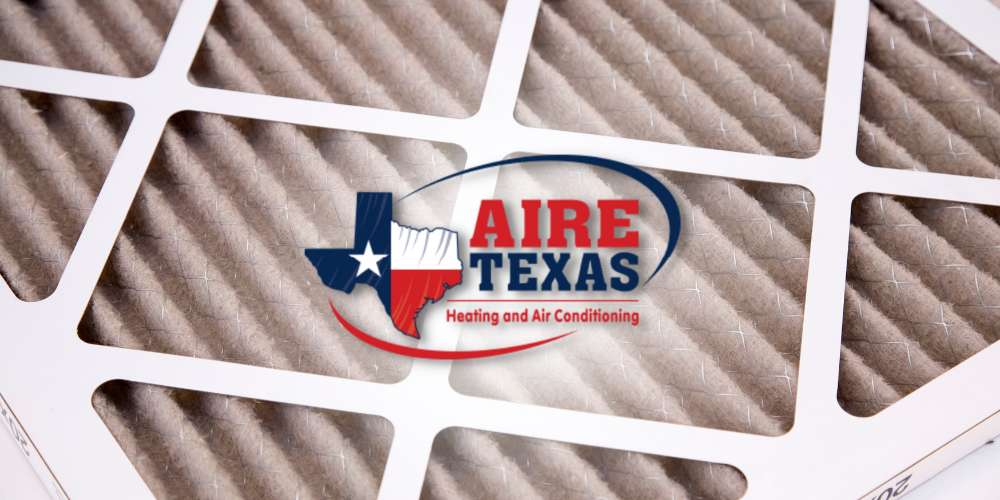When it comes to maintaining a healthy indoor environment, the efficiency and effectiveness of your furnace filter plays an important role. One key term you may encounter when selecting a furnace filter is MERV. MERV ratings help measure a filter’s ability to capture particles of varying sizes, including dust, pollen, pet dander, and other contaminants.
There’s a lot more to understand about MERV ratings when looking for the best air filter for your furnace. That’s why our Plano HVAC contractors at Aire Texas Heating and Air Conditioning are here to help give you the full run-down on what MERV means, why it matters for your North Texas home, and how we can help you choose the right filter to ensure optimal air quality and system performance.
What Does MERV Stand For?
MERV stands for Minimum Efficiency Reporting Value, a system used to evaluate the effectiveness of air filters in capturing particles. Developed by the American Society of Heating, Refrigerating, and Air Conditioning Engineers (ASHRAE), the MERV rating indicates the filter’s ability to remove particles such as dust mites, pollen, pet dander, and mold spores from the air. The rating scale ranges from 1 to 20, with higher numbers indicating better air filtration.
Air filters with higher MERV ratings are more efficient at trapping smaller particles, which is beneficial for people with allergies or respiratory issues. However, higher ratings may restrict airflow if your HVAC system isn’t designed for them.
Choosing the right MERV rating and regularly replacing your air filters can significantly improve indoor air quality and maintain a healthier indoor environment.
What is a MERV Rating?
MERV ratings range from 1 to 20, with higher numbers indicating better filtration of airborne particles. Furnace air filters with a high MERV rating can capture smaller particles, improving your home’s air quality.
High-efficiency particulate air filters often have high MERV ratings, effectively trapping tiny particles like dust, pollen, and mold spores. Lower MERV ratings are suitable for capturing larger particles and are less restrictive on airflow.
Choosing the right MERV rating depends on your home’s indoor air quality needs and your HVAC system’s capabilities. Contact Aire Texas today and let our expert technicians help you determine which MERV filter rating is right for you.
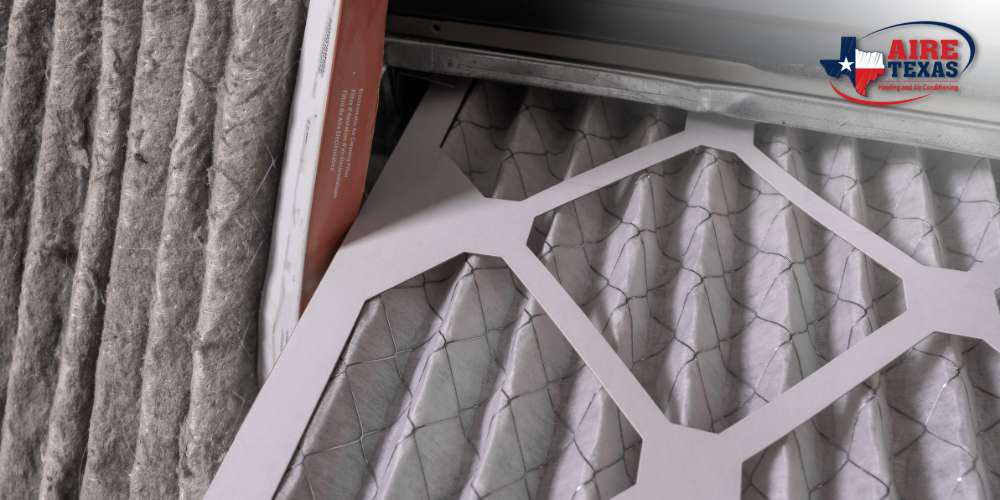
MERV vs FPR
In addition to MERV, there’s also FPR, or Filter Performance Rating, which is another system used primarily by The Home Depot for HVAC filters. FPR ranges from 1 to 10 and includes color codes to simplify selection. While MERV focuses on particle size, FPR considers factors like filter construction and airflow.
Both systems help consumers choose effective furnace filters, but Minimum Efficiency Reporting Value (MERV) is more widely used in industry standards, while FPR is specific to a retail environment.
MERV vs MPR
MPR stands for Microparticle Performance Rating. It is a system used by 3M’s Filtrete brand to measure filter performance. The MPR scale ranges from 300 to 2200, indicating how well the filter captures smaller particles like dust and pollen.
MPR is primarily used in residential HVAC systems to help homeowners choose effective filters, while MERV ratings are used in both residential and commercial settings to assess overall filter performance.
What is the Range of MERV Ratings?
The MERV rating scale ranges from 1 to 20, with the higher numbers indicating filters that are more effective and efficient when it comes to capturing particles of varying sizes.
Lower MERV ratings, such as those ranging from 1-4, are suitable for residential furnaces, capturing larger particles like dust and pollen. Mid-range MERV ratings, typically from 5-13, are common in both homes and commercial buildings, trapping even smaller particles, including mold spores and pet dander. The highest MERV ratings, from 14-20, are primarily used in hospitals and industrial settings, capturing very fine particles, including bacteria and smoke.
What MERV Filter Do I Need?
Selecting the best MERV rating for your air handler or furnace simply depends on your specific indoor environment and air quality needs. Keep in mind that a lower MERV rating, between 1 and 4, is adequate for basic filtration to capture larger particles like dust and pollen.
If you want to improve your home’s air quality further, especially if you have pets, allergies, or anyone with asthma or respiratory issues in your home, a MERV rating between 5 and 8 will do a good job of filtering out pet dander and smaller particles like mold spores. For superior filtration, improving energy efficiency, and removing even smaller particles, a MERV rating between 9 and 13 is recommended.
Higher MERV ratings between 14 and 20 are more appropriate in commercial buildings or industrial settings, capturing the finest particles such as bacteria and smoke. These are not generally recommended for residential settings, as higher ratings can put more strain on your system’s fan. If you’re considering this rating, you’ll need to ensure your air handler can handle the increased resistance.
Balancing filtration efficiency with energy efficiency is key. Regularly replacing your filter also helps maintain your system’s performance and indoor air quality.
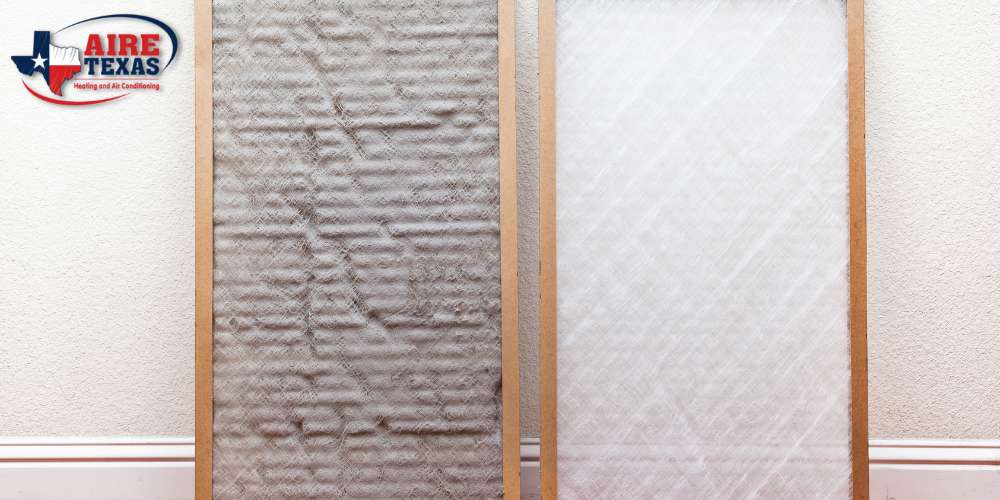
Air Filter MERV Ratings
Selecting the appropriate rating depends on different factors, including the type of HVAC system it’s for, your indoor environment, and any specific air quality requirements. Below, we’ll provide an overview of the MERV rating system as well as some of the most common MERV ratings for different settings and the levels of indoor air contaminants they target.
MERV 1-4
MERV filter ratings of 1-4 are designed for minimal filtration, effectively capturing large particles (as small as 10 microns in size) such as:
- Pollen
- Dust and lint
- Textile fibers and carpet fibers
- Sanding dust
- Spray paint dust
These filters are commonly used in residential settings and window AC units where basic air quality control is sufficient.
MERV 5-8
An air filter with a MERV rating of 5-8 is effective at controlling contaminants between 3 and 10 microns, which includes all of those listed above as well as:
- Dust mites
- Mold spores
- Pet dander
- Hair spray
- Furniture polish
These filters are commonly used in residential settings and light commercial applications.
MERV 9-12
An air filter with a rating of 9-12 on the MERV scale effectively catches small particles 1-3 microns in size such as:
- Welding fumes
- Smoke fumes
- Auto emissions
- Lead dust
- Microallergens
- Bacteria and some viruses
These filters are ideal for commercial buildings and hospital laboratories.
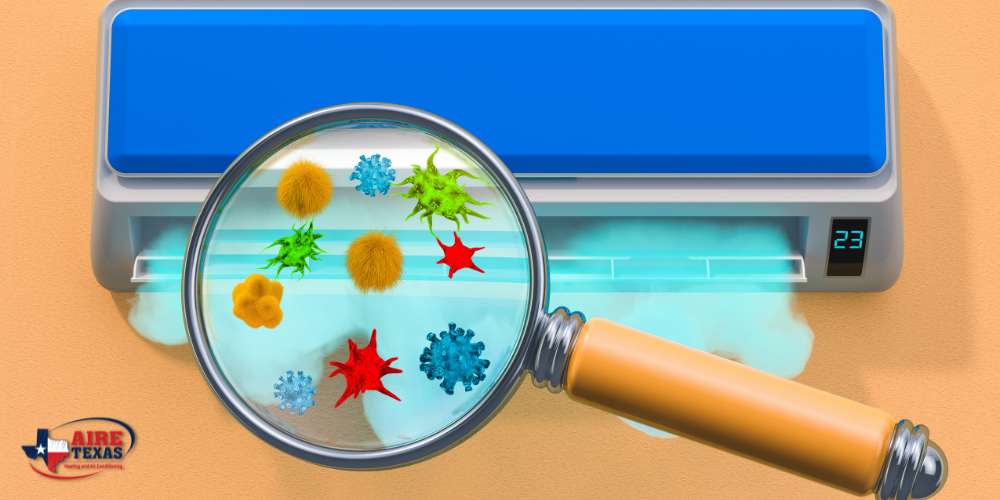
MERV 13-16
An air filter with a MERV rating of 13-16 is highly effective in controlling a wide range of indoor air quality contaminants, including those as small as 0.3 to 1 micron. This includes contaminants such as:
- Smog
- Sneeze particles
- Insecticide dust
- Odors
- Face powder
Due to their ability to capture smaller particles, these filters are commonly used in environments such as commercial buildings, hospitals, general surgery areas, and inpatient care facilities. They are also utilized in smoking lounges to improve air quality.
While these filters are excellent at trapping fine particles, they can significantly increase resistance in the HVAC system, potentially requiring more powerful fans and leading to higher energy consumption.
MERV 17+ (HEPA Filters)
An air filter with a MERV 17+ (HEPA filter) typically controls the finest particles and contaminants such as:
- Virus carriers
- Odors
- Carbon dust
- Insecticide dust
- Combustion smoke
- Sea salt
These filters are often used in clean rooms, pharmaceutical manufacturing, and areas handling radioactive and carcinogenic materials. While highly effective, they can limit airflow and may not be compatible with all HVAC systems.
MERV Rating Chart
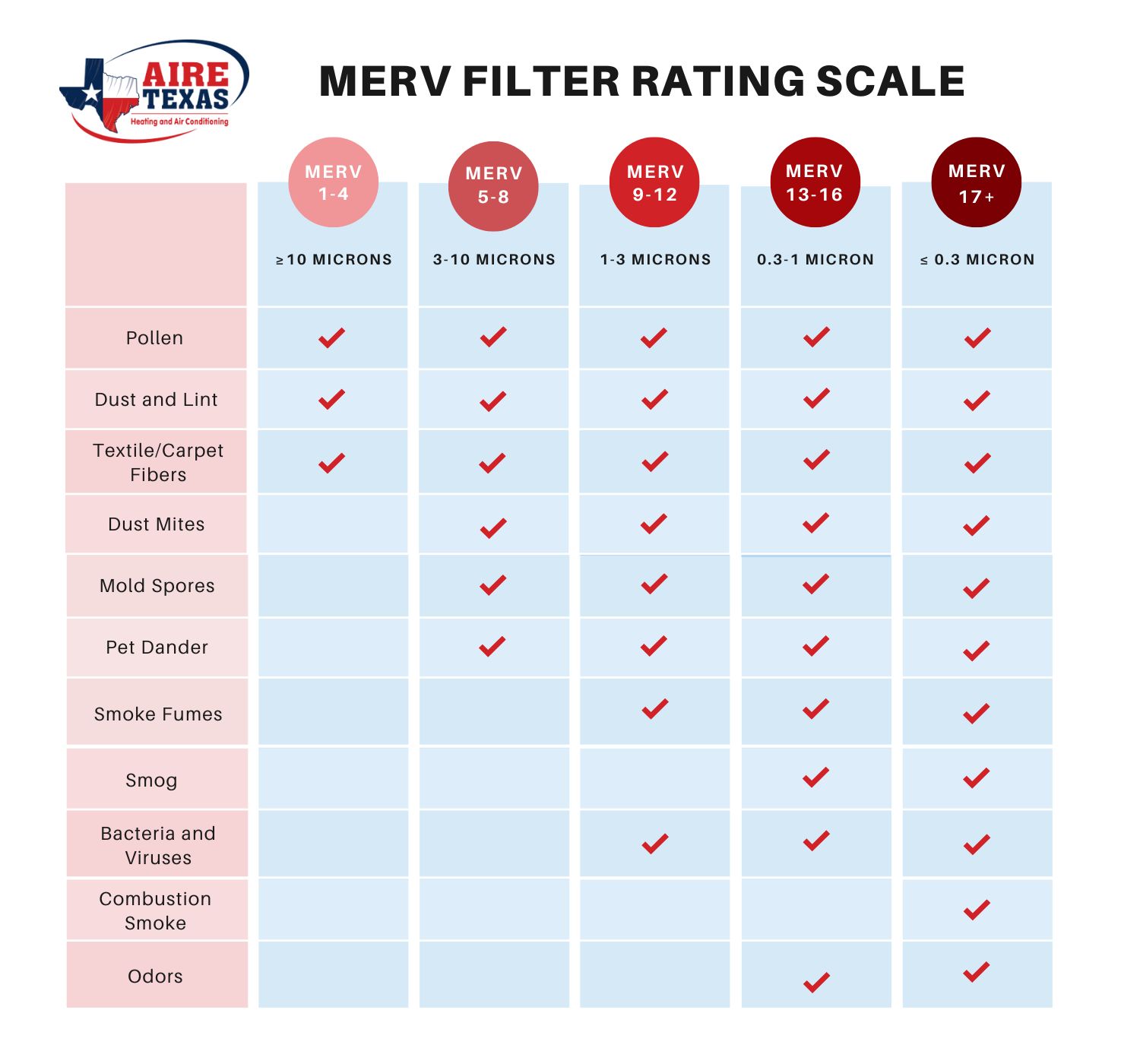
Curious About Which MERV Rating Is Right for Your Plano Home? Call Aire Texas Today!
Choosing the right filter for your home involves considering both filtration needs and energy efficiency. A higher MERV rating means the filter captures more particles, improving your home’s air quality. However, these filters can also increase your energy bill by restricting airflow in your HVAC system.
For most homes, a furnace filter with a MERV rating between 5 and 8 provides a good balance, effectively filtering out common allergens and dust without significantly impacting system efficiency. When installing a new filter, make sure it matches your system’s specifications to maintain optimal performance and air quality.
If you have questions about particle size, the best MERV rating for your home, or other indoor air quality concerns, the Plano indoor air quality specialists at Aire Texas are here to help. Contact us today to discuss how you can improve your indoor air quality and choose the right filter for your HVAC system. Give us a call at (972) 734-1791 or reach out online to get started on improving the quality of your home’s air today!

